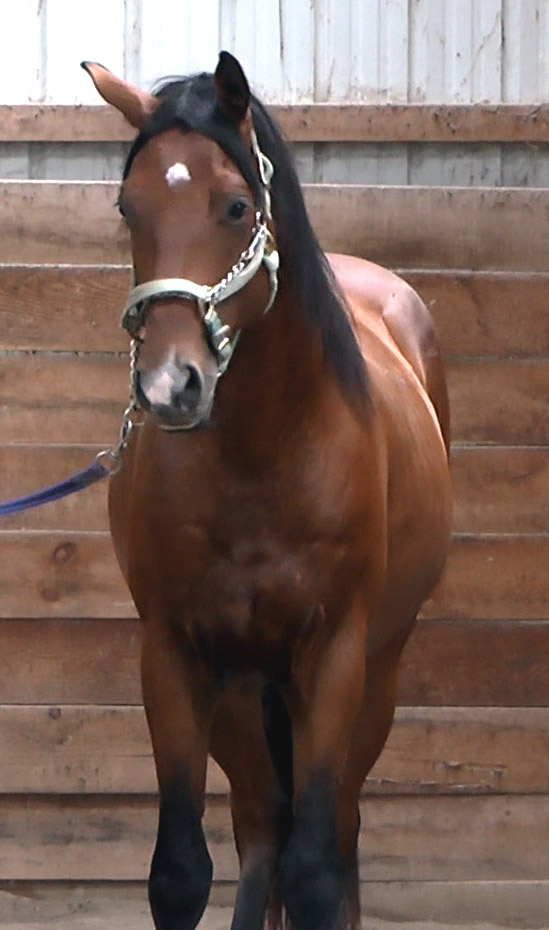Cornell-developed bone marrow concentrate gets young colt back to training condition
Three-year old colt Pistol was only in light training and not under saddle when he suddenly seemed to have pain in a front leg. “He just wasn’t quite right one day,” explains owner Terri Sikora. “It wasn’t that he couldn’t walk, but he wasn’t himself either.” She restricted his play by putting him out to pasture with an older gelding but, within days, his symptoms progressed from slightly off to significant lameness. Sikora then called Dr. Christina Cable of Early Winter Equine.
Cable had X-rays taken of Pistol’s whole leg to see if she could find the source of pain but there was nothing conclusive. She recommended Sikora take Pistol to the Cornell University Equine and Nemo Farm Animal Hospital (ENFAH).
“The sudden and obvious lameness was our biggest concern. Three-year-old colts don’t usually show that amount of pain, so we were concerned it was going to be very bad news,” says Lisa Ann Fortier, Ph.D. ’98, James Law Professor of Equine Surgery at Cornell University.
At Cornell, another X-ray was taken, this time of the shoulder joint specifically, and it suggested bone damage in the area. Again, results were not definitive. “If an X-ray is off by 10 or 15 degrees, it’s easy to miss the injury. It’s not a very sensitive technique,” says Fortier. Pistol then had nuclear scintigraphy, otherwise referred to as a bone scan, to see if it would find what the X-ray could not. This is a very sensitive and more effective diagnostic tool for bone injuries and, in Pistol’s case, it indicated bone damage in the socket part of the shoulder joint.
“It didn’t tell us exactly what the injury was, but it confirmed that the shoulder was the source of his lameness,” explains Fortier, who then recommended diagnostic arthroscopic surgery in the shoulder to determine what the injury was and whether it was reparable.
While the surgical procedure itself is not risky, Fortier points out it was a huge risk and very stressful for the owner because it was an information-gathering mission. “We had no way of knowing what I’d find or if he’d suffered irreparable damage. There just may not be good news at the end of exploratory surgery,” she says. “In this case, Pistol had the best kind of owner who wanted to know everything she could to make the best decision for her horse, as difficult as it might be.”
Sikora agrees the decision to pursue surgery was not an easy one. “I have 20 horses and I bred this one; I’ve had him since he hit the ground,” she says. “The surgical option was intense because if the injury wasn’t reparable, we would put him down on the table.”

During surgery, Fortier saw a half-centimeter of cartilage damage in the socket (glenoid) area of the shoulder. She debrided it and found the underlying bone had mild to moderate damage. The affected cartilage was located right above the bone marrow contusion detected on the bone scan. She believes Pistol jammed his leg and the ball hit the socket, causing damage to bone and cartilage.
In addition to removing the diseased cartilage and bone, Fortier treated Pistol by injecting a bone marrow concentrate into the joint at the end of surgery. The concentrate was derived through a process developed in Fortier’s lab in 2010 (and published in Journal of Bone and Joint Surgery) that includes extracting bone marrow from the sternum and concentrating it in a special centrifuge.
“The concentrate contains stem cells, anti-inflammatories, proteins and growth factors that help repair bone and cartilage to return the joint to normal,” she says. The procedure has since been approved by the Food and Drug Administration for both animals and humans. “It’s an effective way to harvest the body’s ability to heal, so there’s no chance of rejection.”
Sikora was asked to be available by phone during the surgery to discuss options as soon as Fortier determined the nature and extent of the injury. “They called after surgery and treatment were finished and told me he had done well,” she said. “Communication from Cornell was great throughout the whole process.”
After surgery, Pistol was still at risk for greater injury if he fought or panicked as the anesthesia wore off. “He was a true pro,” says Fortier. “He was smart in allowing us to help him get up, which helped in recovery because he didn’t exhaust himself fighting us.”
She also remained worried there might be nerve damage which there was no way to diagnose. This was in large part because of the extent of his lameness. Since going home, however, his recovery has gone so well and so quickly that she’s convinced the pain was caused by the damage found during surgery. Sikora has been following a regimen of stall rest and hand walking and will eventually move him to a full-size turnout.
“In 20 years, I’ve seen a lot of things, but I’ve never had a horse go through regenerative therapy before,” says Sikora. “If it hadn’t been a success we wouldn’t have him, and I’m grateful for that.”
Fortier is also very happy with the outcome and credits the teamwork of the owner, referring veterinarian and Cornell team. “This was the most rewarding case because the owner wants to do the right thing for her horse, the referring veterinarian did all the right diagnosis, and our advanced diagnostic tools and ability to do the arthroscopic surgery brought the process full circle back to the owner. And she has provided the best after-care,” she says.
--By Cynthia McVey




